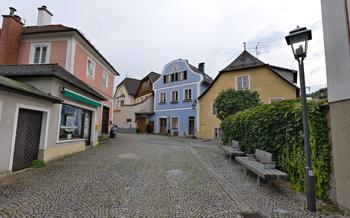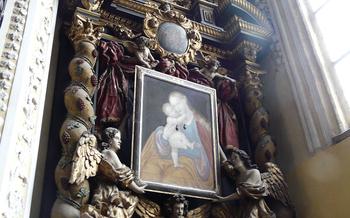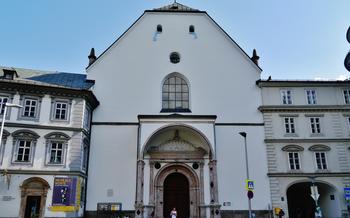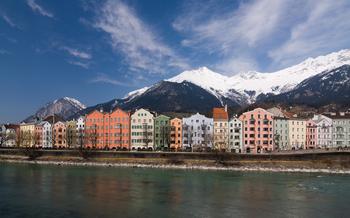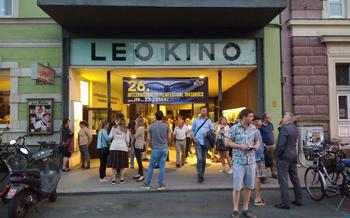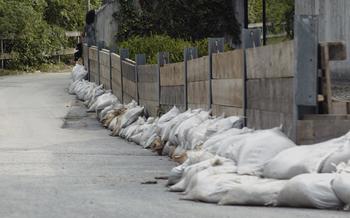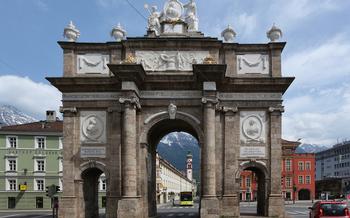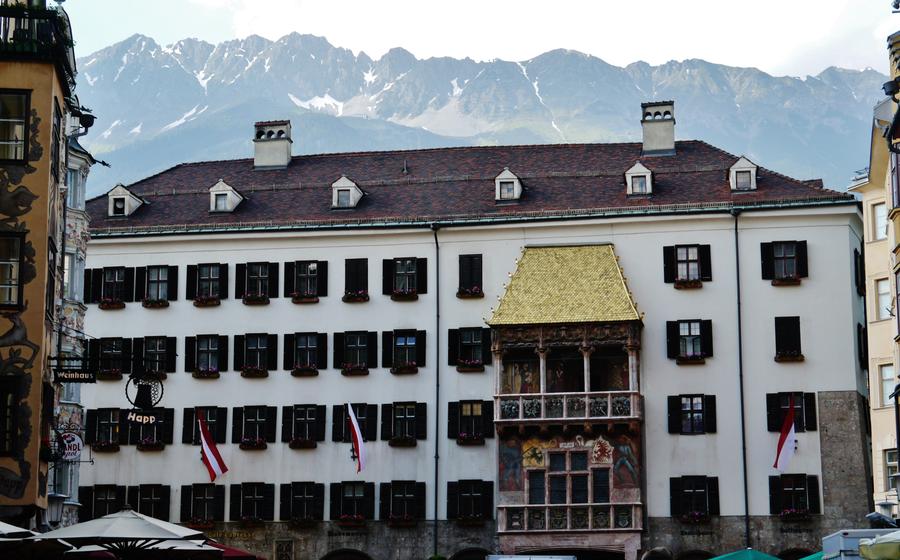
Golden Roof (Goldenes Dachl)
- Golden Roof (Goldenes Dachl)
- History of the Golden Roof
- Architecture and Design
- Cultural Significance
- Location and Accessibility
- Visiting the Golden Roof
- Exploring Innsbruck's Old Town
- Nordkette Mountains and Cable Car
- Hofburg Imperial Palace
- Ambras Castle
- Tyrolean Folk Art Museum
- Innsbruck Cathedral
- Maria-Theresien-Straße: Shopping and Vibrant Atmosphere
- Hofgarten Palace Gardens
- Insider Tip
Golden Roof (Goldenes Dachl)
The Golden Roof (Goldenes Dachl) is a magnificent balcony adorned with intricate golden tiles, nestled in the heart of Innsbruck, Austria. This iconic landmark holds immense historical significance, symbolizing the wealth and power of the Tyrolean rulers. Built in the 15th century by Emperor Maximilian I, the Golden Roof served as a royal viewing platform for festivals and tournaments that took place in the square below. Its ornate decorations and intricate carvings showcase the exquisite craftsmanship and artistic prowess of the era. Today, the Golden Roof stands as a proud symbol of Innsbruck's rich history and cultural heritage, attracting visitors from around the world.
History of the Golden Roof
The Golden Roof was built in 1500 by Emperor Maximilian I, a prominent figure of the Renaissance period. Originally conceived as a balcony for the imperial family to observe festivities and tournaments in the square below, it later became a symbol of Habsburg power and wealth. Over the centuries, the Golden Roof has undergone several changes in ownership and usage. In the 19th century, it was transformed into a museum showcasing the history of the city and the surrounding region. Today, it remains a popular tourist attraction and a testament to Innsbruck's rich past.
Restoration and preservation efforts have been ongoing since the early 20th century to maintain the Golden Roof's structural integrity and its iconic golden tiles. The most recent restoration project, completed in 2008, aimed to preserve the original materials and craftsmanship while incorporating modern conservation techniques. The Golden Roof stands as a living monument, symbolizing the resilience and continuity of Innsbruck's cultural heritage.
Legends and symbolism abound around the Golden Roof. One popular tale claims that Emperor Maximilian I ordered the roof to be covered in gold to demonstrate his wealth and power. Another legend suggests that the golden tiles represent the emperor's desire to create a "golden age" for his people. Regardless of their origins, these stories have contributed to the mystique and allure of the Golden Roof, making it a beloved and instantly recognizable landmark.
Architecture and Design
The Golden Roof's architectural style is predominantly Gothic, with influences from the Renaissance and Late Gothic periods. The use of materials and craftsmanship is exquisite, showcasing the skill and artistry of the time. The roof is made entirely of copper tiles, which were gilded with fire gilding to give it its characteristic golden appearance.
The ornate decorations and symbolism of the Golden Roof are particularly noteworthy. The most striking feature is the series of 26 relief panels lining the roof's edge. These panels depict various scenes from medieval life, including jousting tournaments, hunting expeditions, and allegorical representations of virtues and vices.
The roof's four corner turrets also feature intricate carvings and sculptures. These include figures of emperors, knights, and musicians, as well as heraldic symbols and coats of arms. The overall effect is one of opulence and grandeur, reflecting the wealth and power of the Habsburg dynasty.
One unique feature of the Golden Roof is the small balcony that projects from the center of the façade. This balcony was used by Emperor Maximilian I and his court to observe special events and ceremonies taking place in the square below. It is a testament to the building's multifunctional nature and its importance as a symbol of imperial authority.
Cultural Significance
The Golden Roof is not just an architectural marvel but also holds immense cultural significance for Innsbruck and the region. It stands as a symbol of wealth and power, representing the prosperity and influence of the city during the Middle Ages. The ornate decorations and intricate details on the roof reflect the craftsmanship and artistry of the time.
The Golden Roof is deeply intertwined with Innsbruck's history and identity. It has witnessed significant events, celebrations, and gatherings over the centuries. The balcony has been used for royal proclamations, festive ceremonies, and public performances, making it a central stage for social and cultural life in the city.
Innsbruck's Golden Roof plays a crucial role in tourism and cultural events. It attracts millions of visitors each year, who come to admire its beauty and learn about its history. The roof is a popular venue for concerts, markets, and exhibitions, transforming the Old Town into a vibrant cultural hub.
Recognizing its exceptional value, UNESCO designated the Golden Roof as a World Heritage Site in 200This prestigious status further underscores its importance as a cultural landmark and a symbol of Innsbruck's rich heritage.
Location and Accessibility
The Golden Roof is situated in the heart of Innsbruck's Old Town, a vibrant and historic district renowned for its well-preserved medieval architecture and lively atmosphere. The building is located on Maria-Theresien-Straße, the city's main shopping street, and is surrounded by a myriad of boutiques, cafés, and restaurants. This prime location makes it easily accessible on foot, allowing visitors to seamlessly integrate a visit to the Golden Roof with a leisurely stroll through the Old Town's charming cobbled streets.
Innsbruck's comprehensive public transportation network ensures that the Golden Roof is well-connected to other parts of the city. Several bus and tram lines stop within a short walking distance from the building, making it convenient for visitors to reach the Golden Roof from various points in Innsbruck. For those arriving by car, there are several parking garages located nearby, providing ample parking options.
Moreover, Innsbruck is renowned for its accessibility and caters to visitors with disabilities. The Golden Roof is wheelchair accessible, and the Old Town's streets are generally level and easy to navigate. Accessible public transportation options are also available, ensuring that everyone can conveniently explore this historic district.
Visiting the Golden Roof
The Golden Roof is open to the public, offering visitors a chance to explore its history and admire its intricate craftsmanship up close. Opening hours vary depending on the season, but the attraction is typically open from morning until late afternoon. Admission fees are reasonable, and guided tours are available for those who want to learn more about the roof's history and significance.
To capture the best views of the Golden Roof, consider visiting during the early morning or late afternoon when the sunlight casts a warm glow on the tiles. Photography is allowed, and visitors are encouraged to share their photos on social media. Don't forget to tag #GoldenesDachl or #Innsbruck in your posts!
The Golden Roof is situated in the heart of Innsbruck's Old Town, making it easy to combine a visit with other attractions in the area. The Hofburg Imperial Palace, Innsbruck Cathedral, and the Tyrolean State Museum are all within a short walking distance. After exploring the Golden Roof, stroll through the Old Town's narrow streets, lined with colorful buildings, boutiques, and cafés.
In December, the Old Town transforms into a magical Christmas market, with festive stalls selling traditional crafts, mulled wine, and gingerbread. The Golden Roof provides a picturesque backdrop for the festive celebrations, and visitors can enjoy live music, performances, and the unique atmosphere of Christmas in Innsbruck.
Exploring Innsbruck's Old Town
Innsbruck's Old Town is a captivating labyrinth of narrow streets, colorful buildings, and historical charm. It's the heart of the city, where visitors can wander aimlessly, discovering hidden corners and architectural gems at every turn.
The Hofburg Imperial Palace dominates the Old Town, its majestic presence a testament to Innsbruck's rich history. Other landmarks include the Innsbruck Cathedral, with its Gothic spires and impressive stained glass windows, and the Tyrolean Folk Art Museum, which showcases traditional costumes, crafts, and artifacts of the region.
Shopping enthusiasts will delight in the boutiques and department stores along Maria-Theresien-Straße, Innsbruck's main shopping street. Here, visitors can find everything from souvenirs and handicrafts to high-end fashion. The street also features charming cafés, restaurants, and street performers, creating a lively and vibrant atmosphere.
During the festive season, Innsbruck's Old Town transforms into a magical winter wonderland. The Christmas markets fill the air with the scent of roasted chestnuts, mulled wine, and gingerbread. Stalls selling handmade ornaments, gifts, and local delicacies line the streets, creating a festive and cheerful ambiance.
Whether it's exploring the historic landmarks, indulging in some retail therapy, or simply soaking up the unique atmosphere, Innsbruck's Old Town offers visitors an unforgettable experience.
Nordkette Mountains and Cable Car
Innsbruck is nestled amidst the majestic Nordkette Mountains, offering visitors breathtaking Alpine vistas and a wealth of outdoor activities. To fully experience the region's natural beauty, take a ride on the Hungerburgbahn cable car, a state-of-the-art funicular that whisks you up to the Seegrube and Hafelekar stations, where panoramic views of the city and the surrounding peaks await.
At the Seegrube station, immerse yourself in the stunning scenery from the viewing platform, or embark on a leisurely hike along well-marked trails, leading to picturesque mountain lakes and panoramic viewpoints. Mountain restaurants offer a chance to savor delicious Tyrolean cuisine while enjoying the breathtaking views.
For a more adventurous experience, head to the Hafelekar station, the highest point accessible by cable car. Here, you'll find challenging hiking trails for experienced mountaineers, as well as paragliding launch sites for those seeking an adrenaline rush.
Whether you're a nature enthusiast, an avid hiker, or simply looking for a unique way to experience the Alps, the Nordkette Mountains and the Hungerburgbahn cable car offer an unforgettable adventure.
Hofburg Imperial Palace
In the heart of Innsbruck's Old Town, the majestic Hofburg Imperial Palace stands as a testament to the city's rich history and architectural grandeur. Once the residence of the Tyrolean rulers, the palace complex showcases a blend of Gothic, Renaissance, and Baroque styles, reflecting the evolving tastes and influences of its occupants over the centuries.
Visitors can marvel at the intricate facades, ornate doorways, and elegant courtyards that characterize the palace's exterior. Inside, a wealth of treasures awaits, including opulent state rooms, museums, and exhibitions. The Giant Hall, with its impressive vaulted ceiling and grand chandeliers, is a sight to behold. The Imperial Apartments offer a glimpse into the lavish lifestyle of the Habsburg dynasty, with their finely furnished chambers and personal belongings on display.
The Hofburg Imperial Palace also houses several museums, including the Tyrolean State Museum, which showcases the region's history and culture through interactive exhibits and artifacts. The Court Church, with its intricate frescoes and ornate altars, is a masterpiece of Baroque architecture and a testament to the Habsburgs' deep Catholic faith.
For those seeking a tranquil retreat, the Hofgarten Palace Gardens, adjacent to the palace, provide a serene oasis in the heart of the city. With its manicured lawns, ornamental fountains, and blooming flowerbeds, the garden offers a picturesque setting for a leisurely stroll or a moment of contemplation.
Ambras Castle
On the outskirts of Innsbruck, nestled amidst lush forests and panoramic views, lies Ambras Castle. This Renaissance-style architectural masterpiece was once the residence of Archduke Ferdinand II, a passionate art collector and patron of the arts. Today, it houses one of the most extensive and valuable collections of art and armor in the world.
As you step through the castle gates, you'll be greeted by a courtyard adorned with ornate fountains and sculptures. The interior of the castle is equally captivating, with its grand halls and opulent chambers showcasing a treasure trove of artifacts from different eras and cultures.
Ferdinand II's love for art and history is evident in every corner of the castle. The Chamber of Art and Curiosities is a highlight, displaying an eclectic collection of natural wonders, scientific instruments, and exotic objects from around the world. The Armory, meanwhile, is a testament to the castle's military significance, housing an impressive array of armor, weapons, and battle trophies.
Beyond its artistic treasures, Ambras Castle also boasts stunning gardens that invite you to stroll and admire the meticulously manicured flowerbeds, sculptures, and fountains. The panoramic views from the castle's terraces are simply breathtaking, offering a bird's-eye perspective of Innsbruck and the surrounding mountains.
Whether you're an art enthusiast, a history buff, or simply seeking a picturesque escape, Ambras Castle is a must-visit destination. Its unique blend of Renaissance architecture, world-class collections, and stunning surroundings promises an unforgettable experience.
Tyrolean Folk Art Museum
For a glimpse into the region's rich cultural heritage, visit the Tyrolean Folk Art Museum. This museum showcases a vast collection of traditional Tyrolean costumes, crafts, and artifacts. Explore the exhibits to learn about the history and significance of these items, which range from intricate wood carvings and pottery to colorful textiles and intricate jewelry.
The museum also features interactive exhibits and workshops, providing visitors with an opportunity to engage with the region's folk traditions. Whether you're interested in learning more about Tyrolean customs, trying your hand at a traditional craft, or simply admiring the beautiful displays, this museum is a must-visit for anyone interested in Tyrolean culture.
Located in the heart of Innsbruck's Old Town, the Tyrolean Folk Art Museum is easily accessible and offers a unique insight into the region's past and present.
Innsbruck Cathedral
Innsbruck Cathedral, known as the Dom zu St. Jakob, is a stunning example of Gothic architecture and a prominent landmark in the city's Old Town. Boasting impressive stained glass windows that bathe the interior in vibrant hues, the cathedral exudes a sense of awe and reverence. Its historical significance is profound, serving as the seat of the Diocese of Innsbruck and a witness to centuries of religious and cultural events.
Dedicated to Saint James the Greater, the cathedral's origins date back to the 12th century, though the current structure was largely built in the 15th and 16th centuries. The exterior features intricate carvings and a remarkable portal adorned with sculptures depicting scenes from the Bible. Inside, visitors are greeted by soaring vaults, elegant columns, and a sense of tranquility.
Among the cathedral's highlights are the intricate Hofburg Chapel, accessible from the Hofburg Palace, and the Silver Chapel, which houses a magnificent silver altar. The cathedral also boasts a rich collection of religious art, including paintings, sculptures, and stained glass windows that narrate biblical stories and depict saints and angels.
Maria-Theresien-Straße: Shopping and Vibrant Atmosphere
Innsbruck's main shopping artery, Maria-Theresien-Straße, is a bustling hub of activity. Lined with elegant boutiques, department stores, and souvenir shops, it offers a delightful mix of shopping experiences. Whether you seek high-end fashion, traditional Tyrolean souvenirs, or unique handicrafts, Maria-Theresien-Straße has something for every taste and budget.
The street's vibrant atmosphere is further enhanced by its lively cafés, inviting restaurants, and talented street performers. Take a break from shopping and indulge in a refreshing coffee or a traditional Tyrolean meal while enjoying the lively ambiance.
Maria-Theresien-Straße serves as a gateway to some of Innsbruck's most iconic attractions. At one end, it leads to the Golden Roof, a symbol of the city's rich history. At the other end, it culminates in the majestic Hofburg Imperial Palace, a testament to Innsbruck's Habsburg heritage.
Strolling along Maria-Theresien-Straße is a must for any visitor to Innsbruck. Immerse yourself in the vibrant atmosphere, indulge in some retail therapy, and soak up the city's unique charm.
Hofgarten Palace Gardens
Adjacent to the Hofburg Imperial Palace, the Hofgarten Palace Gardens offer a tranquil oasis amidst the bustling city center. Designed in the Baroque style, the gardens feature ornamental fountains, intricate sculptures, and meticulously manicured flowerbeds. Visitors can stroll along the gravel paths, relax on benches beneath the shade of trees, and admire the beautiful surroundings.
One of the highlights of the Hofgarten Palace Gardens is the Giant's Head Fountain. Created by court sculptor Christoph Gumpp in the 16th century, the fountain depicts a giant's head emerging from a rock, with water spouting from its mouth. The fountain is a popular spot for photos and offers a whimsical touch to the gardens.
Another notable feature is the Sunken Garden, located at the eastern end of the gardens. Surrounded by high hedges, the sunken garden provides a secluded and peaceful retreat. Visitors can admire the colorful floral displays and enjoy the sound of water trickling from the fountain in the center.
The Hofgarten Palace Gardens are open to the public during daylight hours and offer free admission. Visitors can wander through the gardens at their leisure, soaking up the tranquil atmosphere and appreciating the beauty of the surroundings. It's a perfect place to escape the hustle and bustle of the city and enjoy a moment of peace and relaxation.
Insider Tip
To make the most of your visit to Innsbruck, consider these insider tips:
-
Golden Hour Glow: Experience the Golden Roof in a different light by visiting at sunrise or sunset. The warm hues of the golden tiles against the backdrop of the surrounding mountains create a magical and unforgettable sight.
-
Innsbruck Card Advantage: Take advantage of the Innsbruck Card, a tourist pass that offers free or discounted admission to many attractions, including the Golden Roof, as well as unlimited use of public transportation. It's a great way to save money and explore the city conveniently.
-
Discover Hidden Gems: While the Golden Roof is a must-see, don't overlook the charming side streets and hidden gems of Innsbruck's Old Town. Take a leisurely stroll, explore the narrow alleys, and uncover unique shops, cozy cafés, and historical landmarks that offer a glimpse into the city's rich past.
-
Savor Tyrolean Cuisine: Indulge in the culinary delights of Tyrolean cuisine at one of Innsbruck's many traditional restaurants. From hearty dumplings and schnitzel to mouthwatering pastries, there's something to satisfy every palate. Pair your meal with a glass of local beer or wine for an authentic Tyrolean experience.
